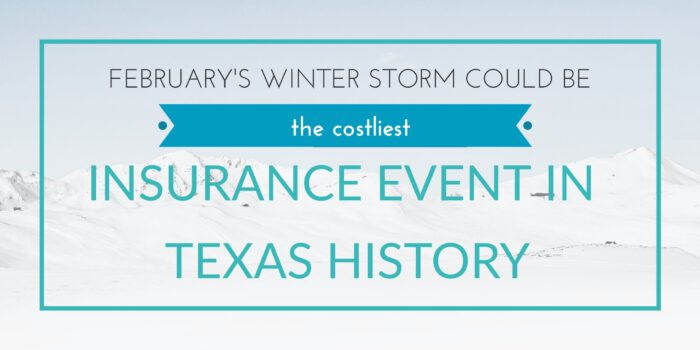 While no firm number on insured losses has been released for the brutal weather system that has left dozens dead and millions without power or water, it is likely to cause billions in auto, property and homeowners claims, with one reported estimate at $18 billion.
While no firm number on insured losses has been released for the brutal weather system that has left dozens dead and millions without power or water, it is likely to cause billions in auto, property and homeowners claims, with one reported estimate at $18 billion.
Winter storms typically cause an average of $1.5 billion in property damage, according to the American Property Casualty Insurance Association (APCIA). That’s the average for ordinary years, but the subzero temperatures and precipitation striking much of the United States falls well outside the standard winter weather for some areas.
A series of meteorological phenomena has affected much of the United States, bringing extreme cold and covering 73% of the nation in snow—a new record according to AIR Worldwide (AIR). The snowfall and ice created by cold air and a low-pressure storm system wreaked havoc in many states, but particularly Texas, as the state is unaccustomed to these types of conditions. AIR noted that 39 of the lower 48 states fell under a winter weather advisory—another first since 2005. New cold temperature records were set around the country, including Dallas, Texas at minus 1 F and Lincoln, Nebraska at minus 31 F.
Texas residents faced ongoing power outages, with the state’s electric grid operator, Electric Reliability Council of Texas (ERCOT), saying the system was seconds or minutes from collapsing in defense of the rolling blackouts. At least 58 people have perished due to hypothermia, auto accidents, fires and carbon monoxide poisoning, according to reports. Nearly half of the state still did not have clean, running water as of Friday, Feb. 19.
The Insurance Council of Texas told a local news affiliate that February’s winter storm could be the largest insurance claim event in state history. By comparison, 2017’s Hurricane Harvey caused approximately $30 billion in insured losses, according to Swiss Re. However, this winter storm has affected a much broader geographical region.
Insurance Impact
In a commentary, AM Best noted the storm damage, along with power outages in Texas, could lead to record property catastrophe losses for the insurance industry in the first quarter of 2021. Homeowners, commercial property and auto insurers face heavy losses due to broken pipes, icy roads, water damage and food spoilage, according to AM Best. Because Texas accounts for a significant portion of the total U.S. direct premiums written for these lines, the impact will be substantial.
“Some insurers are part of the industry’s largest organizations, but others are smaller carriers whose profitability is likely to be impacted significantly by losses, depending on the adequacy of their reinsurance coverage,” according to AM Best, adding that 10 of those insurers have their entire commercial property book in Texas.
Stress on the state’s infrastructure, along with the resources and contractors needed to rebuild from the storm, will add to the complexity and costs. February’s winter storm is a strong reminder of the disruption and destruction that severe weather is capable of. More than 100 million Americans have been affected and, in addition to the devastating experience in Texas, power outages have hit at least 10 other states.
Insurers will also need to keep a close watch on the spiraling consequences of the storm on supply chains. Although the main impact has been on the delivery of COVID-19 vaccines across the nation, electrical supply issues have also caused water, gas and other energy disruptions. Business interruption costs are likely to mount for affected commercial policyholders, and AIR cited delays and damages to agriculture harvests. Texas is a major producer of citrus fruit, much of which could have been destroyed by the cold weather.
For one major commercial property insurer, the last two decades have been leading up to organizations building resilience for events like this. FM Global’s Senior Vice President and Manager of Engineering and Research Brion Callori indicated the fierce winter weather is unusual, but not unexpected. “The unusual snowfall, unusual freeze—it’s not a surprise,” Callori said. “We try to work that into our engineering.”
The key messaging to clients has been around performing a safe shutdown of operations when a deep freeze is coming and maintaining fire operations. After that, businesses should be monitoring for potential leaks, broken pipes and other hazards that come to light when the weather abates and a thaw sets in.
It’s too early to know how losses will develop, especially with the contingent time element and supply chain losses, according to Callori. “Supply chains run very lean and they’ve already been stressed from the pandemic,” Callori said. Being able to respond remotely—another skill perfected during the pandemic—will be key over the next few weeks.
According to Callori, commercial property clients would need to have similar business continuity plans in place for a hurricane or other extreme weather event. After major storms like Katrina, Sandy, Harvey and Maria, businesses have really woken up to being prepared for anything.
“The history over the last 25 years of hurricanes and tropical storms has supported this,” Callori said. “You try to anticipate these things ahead of time so you react properly and are not surprised.”
© 2021 Zywave, Inc. All rights reserved.

